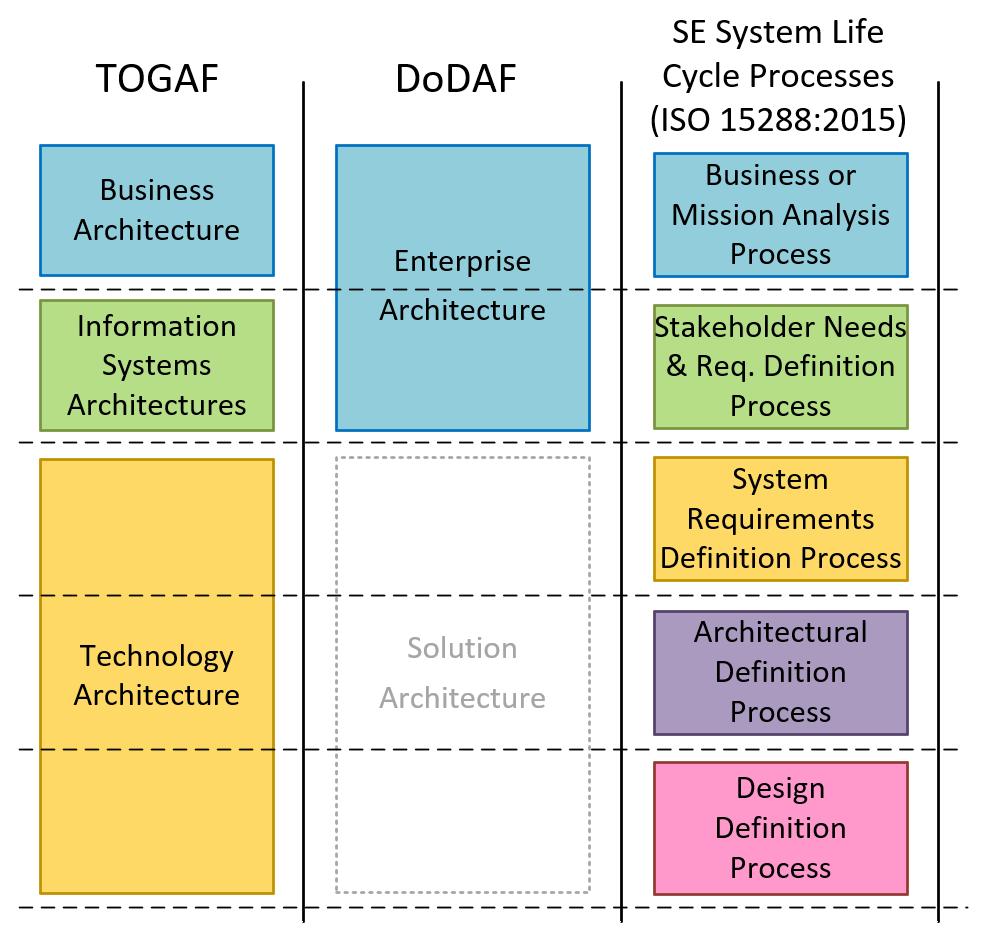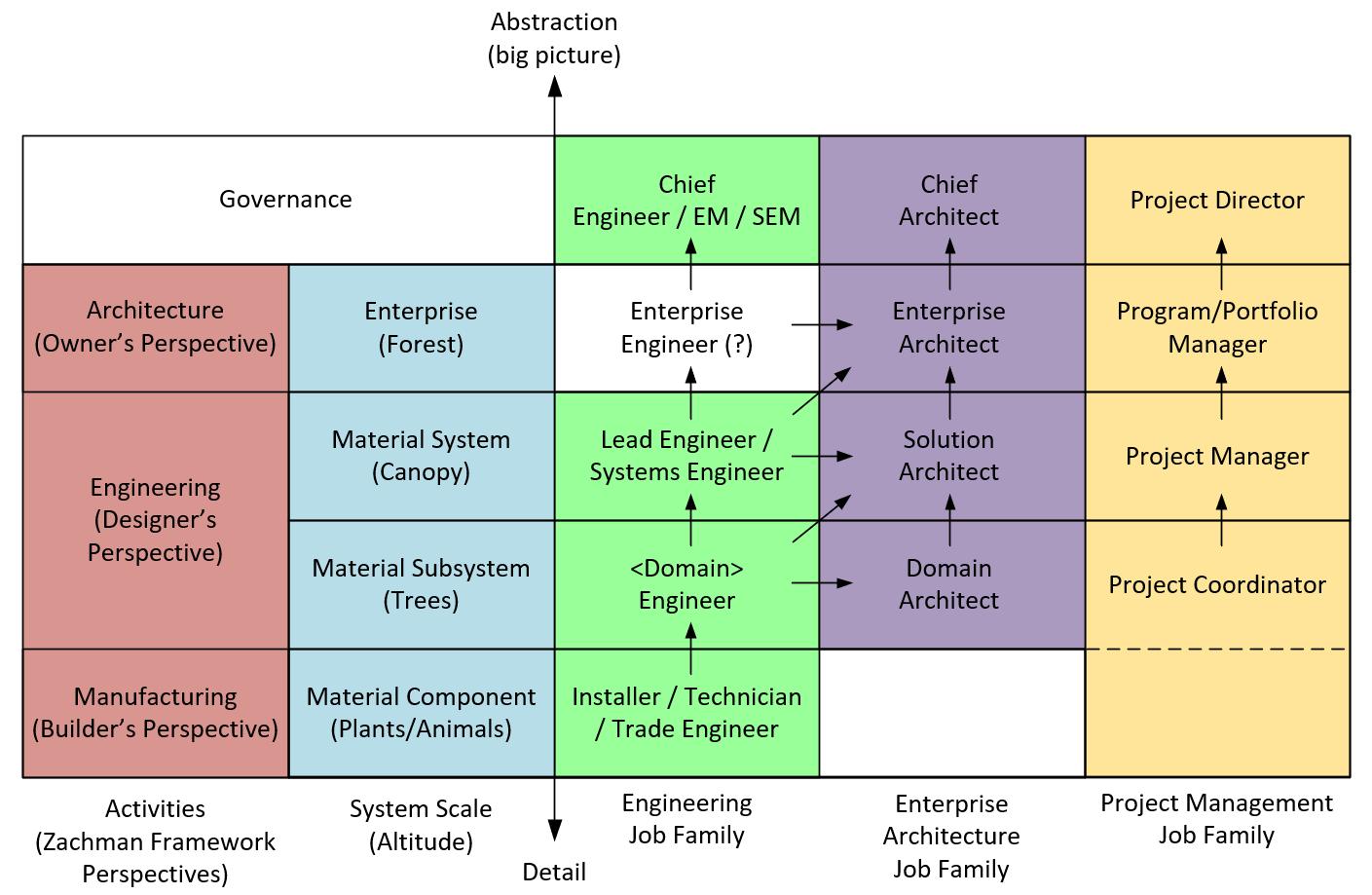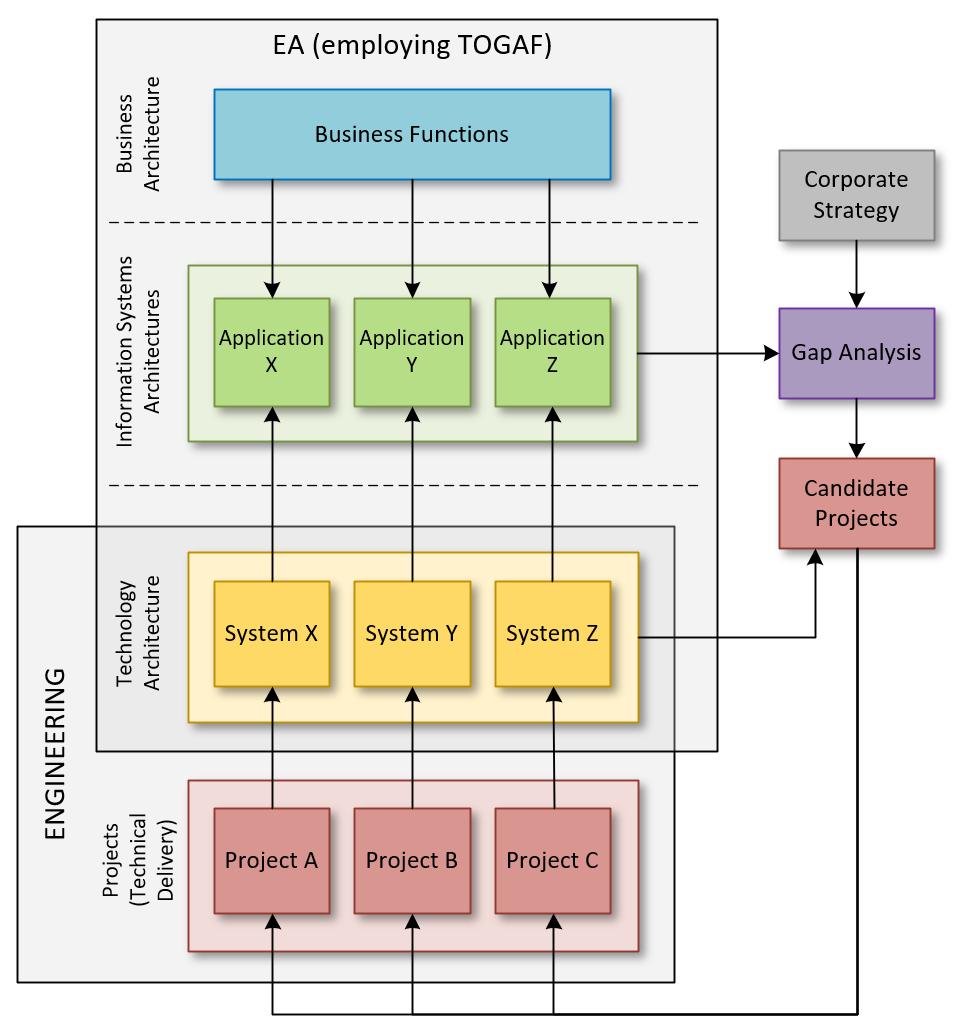
14 minute read
Reconciling Enterprise Architecture and Systems Engineering
These two disciplines have both shared history and shared opportunity to improve the functioning of organizations.
Advertisement
By Thomas Manley
Copyright © 2021 by Thomas Manley. All rights reserved. Authored for PPI SyEN.
Abstract: Enterprise architecture (EA) and systems engineering (SE) have similar history, but there is present-day inconsistency in their descriptions, associated job titles, and perceived relationship. Usage of the terms, “architecture” and “engineering” is widely variant and often ambiguous, further fueling uncertainty as to whether EA is “merely” a sub-discipline of SE. Side-by-side comparison of EA, SE, and project management (PM), aligned against a hierarchical model of an enterprise, reveals the fundamentally complementary nature of EA and SE. Combining EA and SE creates a conceptual methodology that leverages both to achieve desired transformation within the enterprise.
Introduction
The term, “architect” has emerged as a job title within the technology industry in recent decades, typically prepended with a descriptor that identifies either the object or the purpose of that architecture. There has been some confusion as to the actual meaning of these titles, as they are applied inconsistently, and their associated role descriptions vary greatly. Particularly, there is confusion surrounding the distinction between enterprise architects, enterprise engineers, and systems engineers. Is enterprise architecture a discipline or just a sub-discipline within systems engineering?
Etymologies and Geneologies
Architecture in the more traditional sense (the design of buildings and structures) has been around as a human activity since the end of the last ice age (and possibly before). The earliest known structures are the ruins of Göbekli Tepe in Turkey and date from around the 10th millennium BC. As we can see from Figure 1, the word, “architect” has its origin in the mid16th century, from French architecte, from Italian architetto, via Latin from Greek arkhitektōn, from arkhi- (chief) + tektōn (builder). This suggests that the activities of architecture and engineering (at least of

structures) were not originally distinct. For most of that time, the transfer of knowledge between people would have occurred mainly through verbal communication and demonstration rather than formal education.
The term, “engineer” has its origin in Middle English, denoting a designer and constructor of fortifications and of weapons (formerly also as ingineer). It derives from Old French engigneor, which derives from medieval Latin ingeniator (ingeniare = “to contrive or devise”; ingenium = “clever”). Engineering effectively separated from architecture when it became a profession around the 18th century. As technology advanced, engineering branched into the several disciplines that are known today. Of those, systems engineering (SE) is relatively new. The term first appeared in Bell Telephone Laboratories in the 1940s; the first SE course began in 1950; and the first SE book was written in 1957 (Buede, 2016). Meanwhile, the term, “system” was popularized in the rather specialized context of computing and software. The ANSI/IEEE Std 729-1983 IEEE Standard Glossary of Software Engineering Terminology (IEEE, 1983) defined system architecture as, “The structure and relationship among components of a system… may also include the system’s interface with its operational environment.” Similarly, the term, “architectural design” was defined as, “(1) The process of defining a collection of hardware and software components and their interfaces to establish a framework for the development of a computer system. (2) The result of the architectural design process.” This suggests that the concept of architecture was already in common usage within the informationtechnology (IT) industry prior to 1983. When John A. Zachman, often regarded as the father of enterprise architecture, published his Framework for Enterprise Architecture in 1987 (Urbaczewski, 2006), it was initially called the Framework for Information Systems Architecture. Zachman had worked in the marketing division of IBM since the 1960s, so it is not surprising that enterprise architecture (EA) emerged from the need to understand how to build information systems within organizations (The Open Group, 2015). Subsequently, the US Department of Defense’s (DoD) Command, Control, Communications, Computers, Intelligence, Reconnaissance, and Surveillance (C4ISR) Architecture Framework (CAF) version 1.0 was released in 1996 (Blevins, 2010) – the precursor to Department of Defense Architecture Framework (DoDAF). Similarly, The Open Group Architecture Framework (TOGAF) was published in 1995, based upon the DoD’s Technical Architecture Framework for Information Management (TAFIM) that was ultimately cancelled in favor of the DoDAF. It’s less clear where or when the concept of architecture came to be used in the context of systems engineering. Draft MIL STD-499A Systems Engineering (US DoD, 1994) defined functional and physical architecture as a “hierarchical arrangement” of “functions” and of “people, product, and process solutions”. Therefore, at the least, the term, “architecture” has been in use within systems engineering for almost 30 years since 1994.
Types and Roles of Architecture
As might be expected when definitions of architecture vary over time and across presentday usage, there are multiple elaborations and specifications of what constitutes architecture. Architecture is defined in ISO/IEC/IEEE 42020 Software, Systems and Enterprise – Architecture Processes as, “Fundamental concepts or properties of an entity in its environment and governing principles for the realization and evolution of this entity and its related life cycle processes.” In this definition, the keyword is <entity>, as this provides contextual flexibility. Architectural entities are then the “thing being considered, described, discussed, studied or otherwise addressed during the architecting effort”. This allows the term, “architecture” to be prepended with a contextual term of the forms (IEEE, 2019): • <entity> Architecture, where <entity> = {enterprise, organization, solution, system, business, data, application, mission,
product, service, software item, hardware item, network, information systems, technology, etc.} • <subject> architecture, where <subject> = {security, functional, physical, execution, operational, etc.} • <purpose> architecture, where <purpose> = {integration, coherence, design-control, reference, etc.} Such a flexible construct contributes to the diverse ways in which the term, “architecture” is used in the definition and application of processes and of responsibilities. For example, the US’s Department of Defense Architecture Framework (DoDAF) V2.0 describes two major types or layers of architecture (US DoD, 2010): Enterprise architecture: This defines the mission, the information, and technologies necessary to perform that mission, and the transitional processes for implementing new technologies in response to changing needs of that mission. Solution architecture: This defines the elements (and their interrelationships) of a particular project to create, update, revise, or delete activities within the DoD. Essentially, this is a response to the problem-domain statement that was posed in an EA, and it is the most common architecture developed in the DoD. These two layers of architecture within DoDAF correspond approximately to the three layers of The Open Group Architecture Framework (TOGAF): Business architecture: A representation of holistic, multi-dimensional business views of capabilities, end-to-end value delivery, information, and organizational structure, as well as the relationships among these business views and strategies, products, policies, initiatives, and stakeholders. Information-systems architecture: This includes: • Data architecture: A description of the structure and interaction of the enterprise's major types and sources of data, logical data assets, physical data assets, and data management resources. • Application architecture: A description of the structure and interaction of the applications as groups of capabilities that provide key business functions and manage the data assets.
Technology architecture: A description of the structure and interaction of the technology services and components. As seen in Figure 2, the layers both of DoDAF and of TOGAF correspond approximately to the processes of ISO/IEC 15288:2015 Systems and Software Engineering — System Life Cycle Processes (IEEE, 2015). All three models take a somewhat deconstructive approach through successive hierarchical levels: understanding the problem at a particular level; crafting a solution for it that thereby becomes the problem to solve for the next level; and progressing recursively until the concrete, particular solution emerges at the end. According to ISO/IEC 15288, the purpose of the architecture-definition process is, “to generate system architecture alternatives, to select one or more alternative(s) that frame stakeholder concerns and meet system requirements” –which would fall into the solution domain.

Figure 2: Comparing TOGAF, DoDAF, and ISO/IEC 15288:2015

Figure 3: Comparing career hierarchy across multiple related job families
Comparing Career Progressions
Figure 3 aligns the progressions of some typical responsibilities within engineering, enterprise architecture, and project management – all against a system scale within the enterprise (using the forest analogy of “altitude”) and correlated to the three distinct activities that were identified by Zachman (Zachman, 1987). These activities (and the corresponding perspectives that they capture) include: • Architecture (owner’s perspective) • Engineering (designer’s perspective) • Manufacturing (builder’s perspective)
In EA, at the entry level are domain architects who have specific “in-depth knowledge within the particular domain [such as collaboration] of their expertise” (Visual Paradigm, 2021). There exists a natural progression from their scope of responsibility to that of solution architects (who are multi-domain), to that of overall enterprise architects, and eventually to that of a chief architect who provides coordination and governance. (Note the use of “enterprise architecture” to represent both the discipline in general and the scope of one of several specific responsibilities within that discipline.) Similarly, entry-level engineering jobs include installer, technician, or trade engineer, later progressing to a <domain> engineer (such as electrical engineer), then to either a lead engineer (domain-specific) or to a systems engineer (transdisciplinary), and finally to a chief engineer, engineering manager, or systems engineering manager (SEM). For comparison, the project-management (PM) job family has project coordinators, project managers, program/portfolio managers, and project directors whose typical responsibilities encompass increasingly broad sections of the enterprise (roughly aligning to system scale). While this model suggests that an “enterprise architect” might operate at a more strategic level than would an engineer within an enterprise, it leaves open the possibility of equally strategic “enterprise engineer” between the lead engineer and the chief engineer.
Comparing Focus
Clearly, the focus of enterprise architecture is the enterprise itself, and its work product is the macro architecture of the enterprise. However, the focus of systems engineering with respect to an enterprise is less obvious. When SE constitutes the design and development of systems (typically technology-based) within the enterprise, SE tends to be more technical and operational, while EA attends to the functional and strategic. However, if SE is undertaking the enterprise itself as the “system of interest” , EA and SE begin to merge. For this reason, there is overlap in the focus of these two practices, as seen in Figure 4.
This synergy between EA and engineering (in the enterprise context) is evident in a 2015 interview with John A. Zachman, author of the Zachman Framework. “According to Zachman, Walker had figured out how to transcribe enterprise strategy in such a fashion that engineering work could be derived from it.” (The Open Group, 2015). This is a view that is shared by Bellman (2021): “EA is relevant in the initiation of transformation projects, which in turn are handed off to systems architects who in turn provide these models and descriptions to SE implementers”. This suggests that, when seeking to transform an enterprise (or organization), application of a complementary combination of EA and SE may provide the most value. Initially, EA can assess the current state of business functions and applications, then perform capability-gap analysis against corporate strategy. In turn, this can generate candidate SE projects that could advance the enterprise towards its desired target state by creating or improving systems (technical or sociotechnical) within it. Figure 5 uses TOGAF to illustrate this process.
Of course, SE exists throughout the lifecycle of a system, from conceptualization to disposal, not just within the bounds of active projects. Additionally, systems are not required to be framed by the enterprise within which they exist (even if one can be identified). Similarly, projects do not require an EA activity to trigger their establishment.
Further, EA can be regarded as the application of SE when the system of interest happens to be an enterprise. This line of thinking supports the argument that EA is a sub-discipline of SE, or “an engineering method but applied at

Figure 4: Relating EA to SE through quadrants Figure 5: Sequential and complementary nature of enterprise architecture and systems engineering within an enterprise, with focus on technical projects

higher level of IT organization” (Ros, 2019); that is, the subset for which the system-of-interest happens to be an enterprise. Ros contends that enterprise architecture is a sub-discipline of enterprise engineering which is a subdiscipline of systems engineering. This is likely to be a hotly contested viewpoint, however, as many EA practitioners do not have a background in SE (Bellman, 2021).
Summary and Conclusions
In the context of an enterprise, SE typically (but not always) focuses on micro-architecture of a subsystem of an enterprise in the solution domain, while EA tends to focus on the macroarchitecture of an enterprise itself in the problem domain. The two can function in a complementary and sequential manner: EA can identify candidate projects that, if funded, can trigger an SE body of work to deliver new or enhanced systems. Additionally, SE (or engineering more broadly) is not limited to the enterprise context, and systems engineers often can perform the role of an enterprise architect; the reverse is not necessarily true due to the technical nature of SE as an engineering discipline, particularly in the increasingly common case where professional accreditation is required. There can be “name-space collision” between disciplines and job titles within them. It could be helpful to regard systems engineering more as a discipline than as a specific job title, role, or activity. Similarly, there is questionable value of using job titles of the form “<entity> architect”, due to the present inconsistency of such usage and conflation with engineeringrelated job titles. Ambiguous job titles tend to exacerbate the ongoing debate as to whether EA is a subdiscipline within SE or a discipline of its own. Since both their pasts and their futures seem inextricably intertwined, perhaps the debate on terminology and hierarchy can be set aside, to allow focus on the collaborative synergy of EA and SE in improving the effectiveness and the efficiency of enterprises and of organizations.
List of Acronyms Used in this Paper
Acronym Explanation C4ISR Command, Control, Communications, Computers, Intelligence, Reconnaissance, and Surveillance
CAR C4ISR Architecture Framework
DoD Department of Defense (US) DoDAF DoD Architecture Framework
EA Enterprise Architecture PM Project Management SE Systems Engineering SEM Systems Engineering Manager TAFIM Technical Architecture Framework for Information Management TOGAF The Open Group Architecture Framework
Acknowledgements
The author thanks James Gillon (Rob Dobson & Associates) for his incredibly valuable insights across the many discussions on the topic that have informed this paper.
References
Bellman, D. B. (2021, 04 02). Enterprise Architecture and Systems Engineering: Component or Relationship of Disciplines. Retrieved from EA Principals: https://www.eaprincipals.com/content/enterpri se-architecture-and-systems-engineeringcomponent-or-relationship-disciplines Blevins, T. D. (2010). The Open Group Architecture Framework (TOGAF™) and the US Department of Defense Architecture Framework 2.0 (DoDAF 2.0). The Open Group. Buede, D. M. (2016). The Engineering Design of Systems: Models and Methods. New Jersey: John Wiley & Sons, Inc. IEEE. (1983). ANSI/IEEE Std 729-1983 IEEE Standard Glossary of Software Engineering Terminology. NY: IEEE.
IEEE. (2015). ISO/IEC 15288:2015 Systems and Software engineering - System life cycle processes. IEEE. IEEE. (2019). ISO/IEC/IEEE 42020 Software, systems and enterprise - Architecture Processes. IEEE.
Pennsylvania State University. (2021, 04 16). Department History. Retrieved from PennState College of Engineering - Dept of Architectural Engineering: https://www.ae.psu.edu/department/history.as px Ros, M. (2019, 02 26). Enterprise Architecture as a System Engineering Discipline. Retrieved from Medium: https://medium.com/@mikolunar/enterprisearchitecture-as-a-system-engineeringdiscipline-4d1ffff3fb08 The Open Group. (2015, 01 23). A Historical Look at Enterprise Architecture with John Zachman. Retrieved from The Open Group: https://blog.opengroup.org/2015/01/23/ahistorical-look-at-enterprise-architecture-withjohn-zachman/ The Open Group. (2018). The Open Group Architecture Framework (TOGAF) Standard v9.2. The Open Group. Urbaczewski, L. M. (2006). A comparison of enterprise architecture frameworks. Issues in Information Systems, 18-23. US DoD. (1994). MIL-STD 499B Systems Engineering (draft). US DoD. US DoD. (2010). The DoDAF Architecture Framework Version 2.02. US DoD.
Visual Paradigm. (2021). Enterprise Architects vs Solution Architects vs Domain Architects. Retrieved 04 10, 2021, from Visual Paradigm: https://www.visualparadigm.com/guide/enterprisearchitecture/enterprise-architects-vs-solutionarchitects-vs-domain-architects/
Zachman, J. (1987). A framework for information systems architecture. IBM Systems Journal, 276-292.
About the author
Thomas Manley is a Principal Consultant with Downer Defence (Canberra, Australia). He is Systems Engineering Society of Australia’s (SESA) Telecommunications and Cyber Security Domain Lead as well as a foundation member of the SESA Telecommunications Working Group that became an INCOSE working group. He has 20 years' experience in network engineering, systems engineering and enterprise architecture, primarily for Defence and the Australian Tax Office (ATO), having worked with Optus, Telstra, Boeing, and Thales. Between 2013 and 2018, Thomas was Chief Architect of the Optus ATO Account. He holds a CSEP certification, is a CPEng, and has a BE/BSc and an MBA from Australian National University.
FEEDBACK
What do you think: Is enterprise architecture (EA) effectively a sub-discipline within systems engineering (SE), or is EA an independent discipline? Do you have further historical (or personal) perspectives into the early development of SE or EA, or into the adoption of the term, “architecture” within engineering and EA? Let us know: PPISyEN@PPI-Int.com

